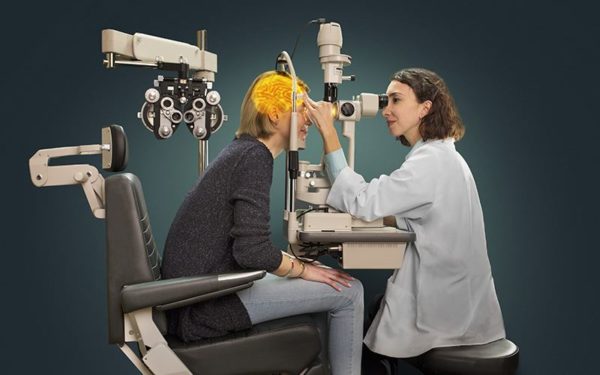Have you ever heard of the retina? Sure you have – it has something to do with the eye. In fact, it’s a very important part of the eye. This week’s article will be dedicated to the retina’s function, anatomy, and related diseases.
The eye is made up of a number of layers that all contribute to communicating information. The retina is located in the back of they eye, opposite the lens and pupil at the front of the eye, and is also made up of various layers. Its position in the eye can be seen below:
Anatomy of the Retina
The retina is a layer of various cells within your eye, and each cell type has their own function. For example, the Rods are photoreceptors that help us see at night and the Cones help us process colour. Our Rods contain something called rhodopsin, which is a light-sensitive pigment that absorbs photons. Our approximately 6 million Cones are made up of tritans, deutrans, and protans. Each are designed for detecting different wavelengths.
Looking above the cellular level, our retinas are made of many layers. But more simply, our retinas can be broken down into two parts – the macula and the peripheral retina. The hyper sensitive, yellow-ish macula sits at the center of our retina, and is responsible for most of our visual capability. The peripheral retina is responsible for the edges of your visual field, making up our peripheral vision.
The Main Retina Function
The retina is similar to a camera, in that it captures an image. The main function of the retina is to help the eye communicate with the brain. In essence, our retina allows our brains to understand what we are seeing.
So how exactly does this all work? Our eyes interpret images through light rays. Light rays enter the cornea through the iris opening – also known as the pupil. The lens then focuses this light onto a specific part of the retina. The retina has light-sensitive cells called photo-receptors, which transform these light rays into electrical impulses. The electrical impulses travel down the optic nerve fibers and into the brain. The brain then decodes these signals, and we ‘see’ an image. You could think of the retina’s electrical impulses like a camera reel, which the brain can understand and from which an image (or picture) is produced.
Retina Related Eye Diseases
The retina is a crucial part of the eye, as mentioned earlier. The retina allows for communication between the eye and the brain. So, if the retina is damaged in any way, it inhibits our ability to see. In some cases, a damaged retina may make a person blind. Some eye diseases and conditions relating to damage of the retina include:
- Retinal detachment occurs when the retina moves from its proper place, hence the term retinal detachment. It is an eye emergency, and immediate treatment is necessary or else permanent vision loss could result.
- Macular hole is the result of nerve cells separating from each other and from the rear surface of the eye
- Macular pucker occurs when the macula contracts
- Retinal vein occlusion can lead to serious vision problems, happening when a blockage prevent blood flow to and from the retina
- Retinitis pigmentosa refers to a bucket of eye diseases caused my genetic mutation
- Diabetic retinopathy can occur in those who have type 1 and type 2 diabetes. The light-sensitive cells in the retina are affected, which can cause blindness.
Want to know more about these eye conditions? Check out our blog!
Taking Care of Your Retina
To ensure your retina and overall eye health is A-Okay, it is critical you do not miss your regular eye exam. It is an opportunity for an eye professional to take a look at your eyes, including the very important retina, and ensure no issues are present. When it comes to our eyes, being proactive is the best course of action against eye issues and diseases. And remember, an eye exam can also help diagnose non-eye related issues too. During your eye exam, be sure to inform the specialist about any changes in your vision or any other oddities.
Another important strategy for protecting your retina is to properly protect your eyes. Wearing glasses or goggles during any kind of sport or activity can help prevent serious and irreversible damage to your eyes.
Book an appointment with one of our optometrists.
Dr. Sharma and our whole team of optometrists at Inner Harbour Optometry strongly believe an eye exam is more than just getting new specs. We love educating our patients on an ongoing basis. If you need a trusted, local Victoria eye care professional, give us a call or book online.
We would love to help you see your very best.
